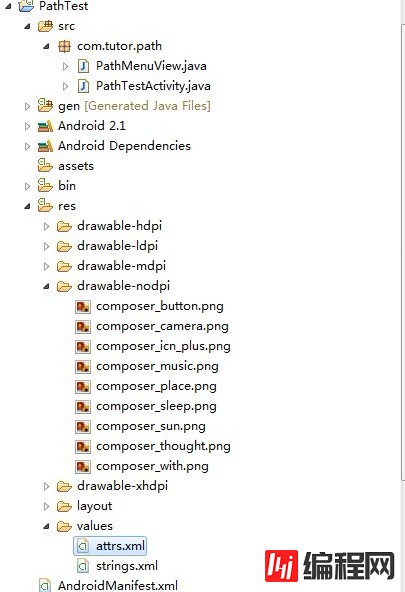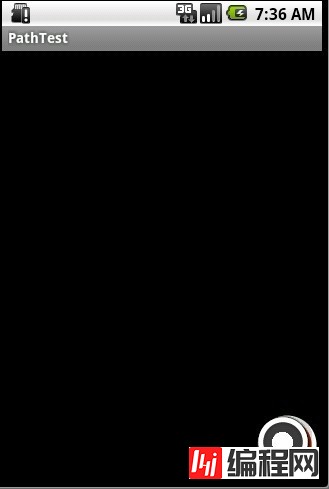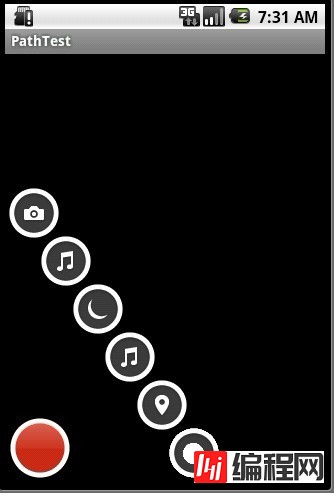Hi~大家好,出来创业快3个月了,一切还不错,前一段时间用了业余时间搞了个问答类网站YQMA.想做中国的stackoverflow,哈哈,只是YY下,希望大家多多支持! 好了,
Hi~大家好,出来创业快3个月了,一切还不错,前一段时间用了业余时间搞了个问答类网站YQMA.想做中国的stackoverflow,哈哈,只是YY下,希望大家多多支持!
好了,今天给大家分享的是Path菜单的简单实现,可以支持自定义方向(左上,右上,右下,左下),并且可以自定义菜单的个数,难点就是菜单的摆放位置(动态设置margin),还有动画的实现,其实动画只是简单用了个TranslateAnimation,N个菜单一起移动的时候感觉很cool~
这里也用到了自定义标签,这里不懂的童鞋可以看我 Android高手进阶教程(四)之----Android 中自定义属性(attr.xml,TypedArray)的使用! 这篇文章.好了废话不多说了,
首先创建一个android工程命名为PathTest.目录结构如下图:
第二步:在values文件夹下新建一个attrs.xml文件,代码如下:
<?xml version="1.0" encoding="utf-8"?>
<resources>
<declare-styleable name="PathMenuView">
<attr name="position">
<enum name="left_top" value="0"></enum>
<enum name="right_top" value="1"></enum>
<enum name="right_bottom" value="2"></enum>
<enum name="left_bottom" value="3"></enum>
</attr>
</declare-styleable>
</resources> 第三步:新建一个PathMenuView.Java这个就是我们自定义的Path菜单控件,代码如下:
package com.tutor.path;
import androidcontentContext;
import androidcontentresTypedArray;
import androidutilAttributeSet;
import androidviewGravity;
import androidviewView;
import androidviewViewGroup;
import androidviewanimationAnimation;
import androidviewanimationAnticipateInterpolator;
import androidviewanimationOvershootInterpolator;
import androidviewanimationTranslateAnimation;
import androidwidgetFrameLayout;
import androidwidgetImageView;
public class PathMenuView extends FrameLayout {
private static final int LEFT_TOP = 0;
private static final int RIGHT_TOP = 1;
private static final int RIGHT_BOTTOM = 2;
private static final int LEFT_BOTTOM = 3;
private int position = 3;
private ImageView mHome;
private Context mContext;
private int mWIDTH = 0;
private int mHEIGHT = 0;
private float mDensity;
private boolean bMenuShow;
private static int xOffset = 15;
private static int yOffset = -13;
private int[] menuResIds = {Rdrawablecomposer_camera,Rdrawablecomposer_music,
Rdrawablecomposer_sleep,Rdrawablecomposer_music,Rdrawablecomposer_place};
public PathMenuView(Context context){
super(context);
setupViews();
}
public PathMenuView(Context context, AttributeSet attrs) {
super(context, attrs);
TypedArray a = contextobtainStyledAttributes(attrs,
RstyleablePathMenuView);
position = agetInt(RstyleablePathMenuView_position,3);
arecycle();
setupViews();
}
private void setupViews(){
mContext = getContext();
mHEIGHT = mContextgetResources()getDisplayMetrics()heightPixels;
mWIDTH = mContextgetResources()getDisplayMetrics()widthPixels;
mDensity = mContextgetResources()getDisplayMetrics()density;
xOffset = (int) (667 * mDensity);
yOffset = (int) (667 * mDensity);
mHome = new ImageView(mContext);
mHomesetImageResource(Rdrawablecomposer_button);
mHomesetOnClickListener(listener);
addView(mHome);
LayoutParams mHomeparams = (FrameLayoutLayoutParams)mHomegetLayoutParams();
mHomeparamswidth = LayoutParamsWRAP_CONTENT;
mHomeparamsheight = LayoutParamsWRAP_CONTENT;
switch (position) {
case LEFT_TOP:
mHomeparamsgravity = GravityLEFT | GravityTOP;
for (int i = 0; i < menuResIdslength; i++) {
int width_padding = mWIDTH / ((menuResIdslength - 1) * 2);
int height_padding = mHEIGHT / ((menuResIdslength - 1) * 2);
ImageView imageView = new ImageView(mContext);
imageViewsetImageResource(menuResIds[i]);
addView(imageView);
LayoutParams params = (FrameLayoutLayoutParams) imageView
getLayoutParams();
paramswidth = LayoutParamsWRAP_CONTENT;
paramsheight = LayoutParamsWRAP_CONTENT;
paramsleftMargin = mWIDTH / 2
- ((menuResIdslength - i - 1) * width_padding);
paramstopMargin = mHEIGHT / 2 - i * height_padding;
paramsgravity = GravityLEFT | GravityTOP;
imageViewsetLayoutParams(params);
}
break;
case RIGHT_TOP:
mHomeparamsgravity = GravityRIGHT | GravityTOP;
for (int i = 0; i < menuResIdslength; i++) {
int width_padding = mWIDTH / ((menuResIdslength - 1) * 2);
int height_padding = mHEIGHT / ((menuResIdslength - 1) * 2);
ImageView imageView = new ImageView(mContext);
imageViewsetImageResource(menuResIds[i]);
addView(imageView);
LayoutParams params = (FrameLayoutLayoutParams) imageView
getLayoutParams();
paramswidth = LayoutParamsWRAP_CONTENT;
paramsheight = LayoutParamsWRAP_CONTENT;
paramsrightMargin = mWIDTH / 2
- ((menuResIdslength - i - 1) * width_padding);
paramstopMargin = mHEIGHT / 2 - i * height_padding;
paramsgravity = GravityRIGHT | GravityTOP;
imageViewsetLayoutParams(params);
}
break;
case RIGHT_BOTTOM:
mHomeparamsgravity = GravityRIGHT | GravityBOTTOM;
for (int i = 0; i < menuResIdslength; i++) {
int width_padding = mWIDTH / ((menuResIdslength - 1) * 2);
int height_padding = mHEIGHT / ((menuResIdslength - 1) * 2);
ImageView imageView = new ImageView(mContext);
imageViewsetImageResource(menuResIds[i]);
addView(imageView);
LayoutParams params = (FrameLayoutLayoutParams) imageView
getLayoutParams();
paramswidth = LayoutParamsWRAP_CONTENT;
paramsheight = LayoutParamsWRAP_CONTENT;
paramsrightMargin = mWIDTH / 2
- ((menuResIdslength - i - 1) * width_padding);
paramsbottomMargin = mHEIGHT / 2 - i * height_padding;
paramsgravity = GravityRIGHT | GravityBOTTOM;
imageViewsetLayoutParams(params);
}
break;
case LEFT_BOTTOM:
mHomeparamsgravity = GravityLEFT | GravityBOTTOM;
for(int i = 0; i < menuResIdslength; i++){
int width_padding = mWIDTH / ((menuResIdslength - 1) * 2);
int height_padding = mHEIGHT / ((menuResIdslength -1) * 2);
ImageView imageView = new ImageView(mContext);
imageViewsetImageResource(menuResIds[i]);
addView(imageView);
LayoutParams params = (FrameLayoutLayoutParams)imageViewgetLayoutParams();
paramswidth = LayoutParamsWRAP_CONTENT;
paramsheight = LayoutParamsWRAP_CONTENT;
paramsleftMargin = mWIDTH / 2 - ((menuResIdslength - i - 1) * width_padding);
paramsbottomMargin = mHEIGHT / 2 - i * height_padding;
paramsgravity = GravityLEFT | GravityBOTTOM;
imageViewsetLayoutParams(params);
}
break;
default:
break;
}
mHomesetLayoutParams(mHomeparams);
}
private OnClickListener listener = new OnClickListener() {
public void onClick(View v) {
if (!bMenuShow) {
startAnimationIn(PathMenuViewthis, 300);
} else {
startAnimationOut(PathMenuViewthis, 300);
}
bMenuShow = !bMenuShow;
}
};
private void startAnimationIn(ViewGroup group, int duration) {
for (int i = 1; i < groupgetChildCount(); i++) {
ImageView imageview = (ImageView) groupgetChildAt(i);
imageviewsetVisibility(0);
MarginLayoutParams mlp = (MarginLayoutParams) imageview
getLayoutParams();
Animation animation = null;
switch (position) {
case LEFT_TOP:
animation = new TranslateAnimation(0F,-mlpleftMargin+xOffset,0F,-mlptopMargin + yOffset);
break;
case RIGHT_TOP:
animation = new TranslateAnimation(mlprightMargin - xOffset,0F,-mlptopMargin + yOffset,0F);
break;
case LEFT_BOTTOM:
animation = new TranslateAnimation(0F, -mlpleftMargin+ xOffset, 0F, -yOffset + mlpbottomMargin);
break;
case RIGHT_BOTTOM:
animation = new TranslateAnimation(mlprightMargin-xOffset,0F,-yOffset + mlpbottomMargin, 0F);
break;
default:
break;
}
animationsetFillAfter(true);
animationsetDuration(duration);
animationsetStartOffset((i * 100) / (-1 + groupgetChildCount()));
animationsetInterpolator(new OvershootInterpolator(2F));
imageviewstartAnimation(animation);
}
}
private void startAnimationOut(ViewGroup group,int duration){
for (int i = 1; i < groupgetChildCount(); i++) {
final ImageView imageview = (ImageView) group
getChildAt(i);
MarginLayoutParams mlp = (MarginLayoutParams) imageviewgetLayoutParams();
Animation animation = null;
switch (position) {
case LEFT_TOP:
animation = new TranslateAnimation(-mlpleftMargin+xOffset,0F,-mlptopMargin + yOffset,0F);
break;
case RIGHT_TOP:
animation = new TranslateAnimation(0F,mlprightMargin - xOffset,0F,-mlptopMargin + yOffset);
break;
case LEFT_BOTTOM:
animation = new TranslateAnimation(-mlpleftMargin+xOffset,0F, -yOffset + mlpbottomMargin,0F);
break;
case RIGHT_BOTTOM:
animation = new TranslateAnimation(0F,mlprightMargin-xOffset, 0F,-yOffset + mlpbottomMargin);
break;
default:
break;
}
animationsetFillAfter(true);animationsetDuration(duration);
animationsetStartOffset(((groupgetChildCount()-i) * 100)
/ (-1 + groupgetChildCount()));
animationsetInterpolator(new AnticipateInterpolator(2F));
imageviewstartAnimation(animation);
}
}
} 第四步:PathTestActivity.java以及用到的布局文件main.xml代码如下:
PathTestActivity.java(基本没修改代码)代码如下:
package comtutorpath;
import androidappActivity;
import androidosBundle;
public class PathTestActivity extends Activity {
@Override
public void onCreate(Bundle savedInstanceState) {
superonCreate(savedInstanceState);
setContentView(Rlayoutmain);
}
} main.xml代码如下:
<?xml version="0" encoding="utf-8"?>
<LinearLayout xmlns:android="Http://schemasandroidcom/apk/res/android"
xmlns:tutor="http://schemasandroidcom/apk/res/comtutorpath"
android:layout_width="fill_parent"
android:layout_height="fill_parent"
android:orientation="vertical" >
<comtutorpathPathMenuView
android:id="@+id/text"
android:layout_width="fill_parent"
android:layout_height="fill_parent"
tutor:position="right_bottom"
/>
</LinearLayout> 运行点击效果如下:

图1:默认是在右下方这里menuResIds定义了五个菜单

图2:点击红色菜单,菜单收回.
下面我们修改main.xml的tutor属性为left_bottom,并且修改PathMenuView.java中的menuResIds.
tutor:position="left_bottom" 效果如下:

图3:自定义在左下角,六个菜单。
--结束END--
本文标题: Android高手进阶教程(二十六)之---Android超仿Path菜单的功能实现!
本文链接: https://lsjlt.com/news/23143.html(转载时请注明来源链接)
有问题或投稿请发送至: 邮箱/279061341@qq.com QQ/279061341
2024-01-21
2023-10-28
2023-10-28
2023-10-27
2023-10-27
2023-10-27
2023-10-27
回答
回答
回答
回答
回答
回答
回答
回答
回答
回答
0